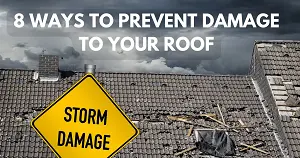Imagine waking up to a leaky roof on a rainy morning, or witnessing the cracked shingles that have compromised your home’s appearance. Such issues can cause not only inconvenience but also hefty repair costs. But what if we told you these problems could be avoided altogether? As surprising as it may sound, this is where our skilled industrial roofers step in to save the day! Welcome to our comprehensive guide: ‘8 Ways To Prevent Damage To Your Roof.’ This article will arm you with knowledge and tips straight from expert industrial roofers to fortify your rooftop against any potential damage. So read on, because a stitch in time truly does save nine!
1. Keep Your Gutters Clean
Industrial roofers know better than anyone the crucial role gutters play in keeping a structure free from water damage. As mundane as it may seem, maintaining a clean gutter system is not just about aesthetics; it’s an essential preventative measure that safeguards your property against costly repairs and structural complications down the line.
Intriguingly, beyond merely directing rainwater away from your building, clean gutters can significantly improve your property’s lifespan. Industrial roofers have long discovered that leaves, twigs, and debris clogging up these channels often foster moisture buildup that invites rusting and decay. Therefore, take a cue from these experts: inspect regularly for signs of blockage or damage and ensure proper cleaning. Remember, it isn’t just about saving money but securing peace of mind by knowing you’ve done all there is to protect your valuable investment.
2. Trim Overhanging Trees
As homeowners, we often forget the looming giants in our yard, until their branches hang over your roof like unwelcome arms reaching out. But there’s more to these overhanging trees than just a simple aesthetic challenge – they pose risks to the structural integrity of your home as well. Strong winds or storms can send those limbs crashing onto your property below, causing unprecedented damage and serious safety concerns.
Trimming overhanging trees not only enhances the view of your lovely abode but also adds an extra protective layer to keep impending hazards at bay. It reduces leaf litter on roofs, which minimizes potential moisture accumulation leading to gradual decay. Simply put: prudent care of these green sentinels brings peace of mind while preserving beauty and security—so why not invest time in tending them?
3. Install Proper Ventilation
Taking a walk on the roofs, you might not comprehend the significance of those incredibly designed and strategically placed vents. These integral parts of your roof perform an all-too-vital role that silently contributes to the overall wellness of your beloved home. Balancing indoor air moisture, controlling temperature fluctuations, and avoiding build-up of harmful molds are just tips on their colossal iceberg of benefits.
Installing proper ventilation in your roof thus becomes far from an architectural embellishment but leans towards a necessity with awe-inspiring returns. The choice between enduring swelteringly hot summer days or curling up in a cocoon during cold winter evenings hinges largely on widely overlooked vents dotting our roofs. It’s about time we gave them their deserved attention and importance – for they guard our comfort more fiercely than we give them credit.
4. Inspect Your Roof Often
Like the human body, your roof equally needs a checkup to guard against the unpredicted. Allowing it to be in perfect shape not only protects it from damage but also elongates its shelf-life. The frequency of a “roof inspection diet” should not be under-emphasized: season changes, severe weather conditions, and after unprecedented natural disasters are times when attention is needed most.
Safety – why gamble? A neglected roof can lead to major casualties such as leaks, ceiling damage, or even collapses. Moreover, identifying these issues earlier comes with financial savings; making regular visual inspections on your own and then getting professional help when noticed an oddity creates a cost-effective approach in maintaining this part of your dwelling place. Remember that a good roof over our heads is an emblem of protection; let’s keep it intact!
5. Avoid Walking on Your Roof
Visiting your rooftop might seem like an adventurous idea, potentially giving you a fantastic view of your surroundings. However, unless explicitly designed for walking, roaming around on your roof can lead to unforeseen troubles both for yourself and the structural integrity of your home.
The roofer’s realm is not a forgiving one. Apart from immediate safety concerns such as slips or falls that can cause serious injuries, there are other subtler perils in the form of damaged shingles or underlayment leading to leaks and water damage which can be costly down the line. An average roof consists of several layers each carefully installed; once disturbed it takes experience and expertise to properly restore them into place. So let’s leave this daredevil domain to professionals entrusted with special training and equipment: curbing our curiosity could spare us significant discomforts!
6. Be Careful with Roof Mounted Equipment
Numerous problems on roofs can be traced back to roof-mounted appliances. Such equipment is particularly common on commercial properties where large air conditioning units are typically found, but it’s not unusual to see them on residential properties as well, like satellite dishes for example. If you have a need to install such equipment, extreme caution is required because even the tiniest hole in your roof can result in water seeping into the building and causing significant damage. It’s highly recommended to engage a professional who can guarantee a secure installation and confirm that the roof remains functional and in good condition.
7. Keep Debris Away from Your Roof
Imagine the comfort of a warm evening spent indoors during a thunderstorm, only to have it disrupted by the sudden onset of leaks pouring in from your ceiling. The culprit? Debris accumulated on your roof! Not just an eyesore, over time, leaves, branches, and other discarded specimens can cause serious damage to your roofing structure.
Leaving debris unattended on your rooftop invites moisture entrapment, possibly leading to mold growth and wood rot. What’s more astonishing is how twigs and leaves can create tiny dams over time causing roof valleys to flood during rainfall. It truly exemplifies the phrase ‘small things making a big difference.’ So appropriately managing debris could be all that stands between you and a hefty repair bill tomorrow!
8. Seek Professional Advice
Undoubtedly, for top-tier roof care, it’s highly recommended to consult a professional (T Samuels Industrial Roofing). If there are any doubts about the safety of your roof, it’s always wise to have an experienced professional inspect it. They have the ability to identify potential issues and offer sound guidance on addressing them before they escalate into major problems.


